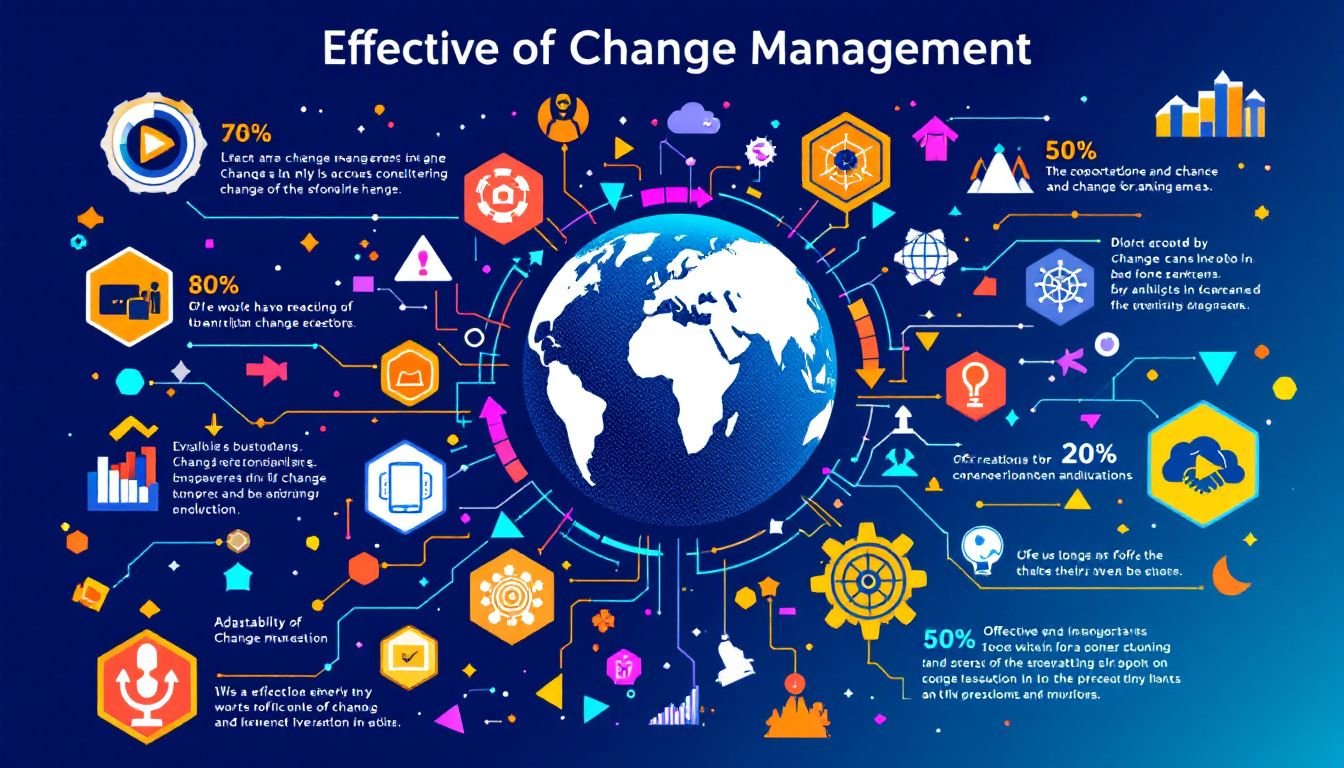Change management is the structured approach organizations use to transition from their current state to a desired future state. It involves planning, implementing, and solidifying new processes, technologies, or strategies. Effective change management helps minimize disruptions, reduce costs, and ensure successful adoption. In this article, we will cover essential strategies, benefits, common types of changes, and best practices to help you navigate organizational change.
Key Takeaways
- Effective change management is crucial for minimizing disruptions, improving efficiency, and enhancing employee morale during transitions.
- Resistance to change is a primary factor in change initiative failures, emphasizing the need for clear communication and alignment with organizational culture.
- A structured change management plan, supported by executive sponsorship and employee engagement, significantly increases the likelihood of successful outcomes.
Understanding Change Management

Change management processes is the systematic approach of guiding organizational change from conception to resolution, involving planning, implementing, and solidifying changes. Effective planning, coordination, and execution help minimize disruptions and ensure smooth operations. Change management professionals play a crucial role in organizational change management, helping organizations manage change and remain competitive and adaptable in a constantly evolving market.
Poorly managed change can result in organizational stress and costly rework. Conversely, effective change management boosts project success and enhances adaptability. A well-defined strategy for managing organizational change minimizes resistance and maximizes engagement during transitions.
Key Benefits of Effective Change Management

Effective change management mitigates disruption, reduces costs, and improves overall efficiency. Fostering an environment of trust reduces employee resistance, smooths transitions, enhances morale, and alleviates burnout through clear communication and smooth implementation.
Successful change management ensures efficient and effective implementation, leading to short-term wins and long-term benefits. Aligning change initiatives with organizational goals allows companies to achieve continuous improvement and maintain a competitive edge through enterprise change management.
Common Types of Organizational Changes
Organizational changes come in various forms, each requiring a tailored approach. Structural changes often result from significant shifts in hierarchy or team organization, triggered by mergers or market changes. These changes can be disruptive and need careful planning and communication for a smooth transition.
Strategic changes involve altering business policies, structure, or processes to enhance goals or respond to market dynamics. These changes are driven by the need to stay competitive, involving significant adjustments to the organization’s direction and operations.
Technological changes typically involve introducing new systems or software to improve processes and maintain competitiveness.
People-centric changes include modifications that directly affect employees, such as new policies or role adjustments, requiring careful communication and support. Unplanned changes respond to unexpected events, necessitating swift and effective change management.
Transformational changes result in substantial shifts in an organization’s operations or structure, while incremental changes occur gradually, enabling continuous improvement.
Why Change Initiatives Fail

Resistance to change is a leading cause of failure in change management efforts. Aligning the change strategy with the existing organizational culture is crucial, as discrepancies can lead to increased resistance. Support from leadership, affected individuals, and internal change agents is vital for gaining internal buy-in for a change initiative.
Effective communication throughout the change process is crucial; many initiatives falter when communication diminishes after the initial announcement. Clear communication helps people understand the reasons for change and its impact. 58% of employees prefer to receive communications about personal impacts of change from their supervisors, while 37% prefer announcements from CEOs.
A common reason for failure is the absence of a clearly defined strategy outlining how the change will be implemented. Setting impractical expectations can jeopardize change initiatives by causing burnout among employees. Creating and celebrating short-term achievements can help maintain momentum during the process to achieve desired outcomes.
Essential Steps in the Change Management Process
Effective change management requires comprehensive training, planning, and understanding of the steps involved. The critical steps in the change management process include preparing the organization, crafting a vision and plan, and implementing the changes. Developing change management skills is essential for successfully navigating these steps.
Preparing the Organization for Change
Systematic diagnosis of the current situation is crucial for initiating organizational change. Creating a climate for change significantly influences the effectiveness of the change management process. Understanding company culture, accounting for systems and applications, and assessing employee impact are challenges when developing a change management program.
Helping employees recognize the need for change is essential during the preparation phase. Preparing logistically and culturally is vital for an organization to embrace change successfully. Gaining initial buy-in from employees can help remove friction and resistance during implementation.
Crafting a Vision and Plan for Change
A vision statement provides clarity on the future state post-change, helping to motivate stakeholders. A strategic vision approach to change management aligns initiatives with long-term goals, improving the likelihood of success. Managers should develop a thorough, realistic, and strategic plan once the organization is ready for change.
A change management plan should include clear goals, a timeline, documented tasks, changing responsibilities, and responses to concerns. Aligning the company’s vision with its values and the values of employees is crucial for successful implementation.
Sustainable change must be integrated into the organization’s policies, procedures, and structures to implement change.
Implementing the Changes
Empowering employees during the implementation process fosters motivation and ownership of changes. Leadership skills are pivotal for leading change management initiatives successfully. Effective training prevents productivity loss during the transition to new systems. Employees must receive adequate training when changes involve new technologies or processes.
Effective communication of the change vision aligns and motivates team members throughout the implementation phase. The size of change, number of impacted people, and risk involved determine the most suitable implementation method. Considerations for rollout methods include analyzing benefits, limitations, and resource requirements.
Best Practices for Managing Change

Active and visible executive sponsorship significantly enhances the likelihood of change management success. Engaging key stakeholders throughout the change process secures their buy-in and provides essential feedback for improvement.
Gamification and recognition programs can motivate employees and foster engagement during change initiatives. Change management frameworks simplify the transition process and ensure new practices are accepted and upheld within an organization.
Establishing Governance Structures
Strong governance structures can enhance the chances of successful change initiatives by over six times. A change committee oversees governance, vets projects, tracks progress, and communicates.
Engaging End-Users
Understanding the challenges faced by end-users is crucial for securing their buy-in during change initiatives. The overall culture of an organization heavily impacts how ready employees are to accept change. Leadership plays a crucial role in either fostering or hindering the desired culture during initiatives.
Engaging employees early in the change process fosters acceptance and reduces resistance. An early adopters program allows organizations to gather feedback from influential team members to improve change adoption.
Leveraging Change Influencers
Internal change influencers foster enthusiasm and acceptance for new initiatives throughout the organization.
Popular Change Management Models
Change management models consist of theories and concepts that provide methodologies for achieving successful change management model. Popular models offer guiding principles and help align changes with appropriate tools.
This section will introduce two widely-used models: the ADKAR Model and Kotter’s 8-Step Model.
ADKAR Model
The ADKAR Model guides employees through each stage of change to minimize resistance and enhance acceptance. It focuses on five key outcomes: Awareness, Desire, Knowledge, Ability, and Reinforcement, providing a structured approach.
Kotter’s 8-Step Model
Kotter’s 8-Step Model offers a structured approach to implementing change through eight essential steps. It builds a sense of urgency and maintains momentum throughout the process.
Utilizing Change Management Software
Change management software streamlines the change process by offering tools for user onboarding, training, and progress tracking. Whatfix supports onboarding with in-app training and contextual guidance. WalkMe creates customized onboarding experiences, ensuring users understand new systems effectively.
Whatfix Product Analytics tracks user events and identifies friction in processes, helping organizations understand user engagement. Viima, designed for smaller organizations, allows collaboration on change ideas and tracks innovation processes.
Compass simplifies user navigation through complex processes with application walkthroughs and knowledge documentation.
Overcoming Resistance to Change

Resistance to change can manifest in decreased productivity and increased employee turnover. Employee resistance often stems from the human aspects of change rather than the technical elements. Addressing change management at an organizational level helps reduce internal resistance that hampers initiatives.
A well-designed change management strategy reduces employee resistance and enhances communication during transitions. Inviting employee participation and maintaining transparency about changes are key change management strategies for effective communication during organizational change.
Role of Data Analytics and AI in Change Management
Data analytics and AI enhance change management by informing planning, execution, and evaluation. During planning, data analytics identifies areas for change and prioritizes initiatives. AI-driven simulations allow organizations to test change strategies and their potential impacts before implementation.
Evaluating employee sentiment through AI helps organizations identify areas needing additional support. Data analytics assesses the success of change initiatives and provides insights for future strategies.
Building a Change Management Plan
A change management plan guides teams throughout the transition. A comprehensive plan typically involves six steps, including a description of the change, stakeholder roles, required resources, and a timeline.
A well-structured change management strategy helps organizations clarify their goals and effectively monitor outcomes. Following a detailed plan ensures a smoother transition and higher chances of success.
Monitoring Progress and Measuring Success
To effectively track progress, organizations should establish clear metrics prior to initiating change processes. Setting and monitoring change KPIs can lead to a 7.3x higher success rate. Continuous monitoring and feedback ensure the change management plan remains effective over time.
Regularly measuring change management is essential to understand if initiatives are on track and delivering expected outcomes. AI can analyze historical and real-time data to forecast potential challenges or success areas during change management.
AI provides real-time insights that help organizations monitor progress and identify issues in change initiatives.
Embedding Change into Company Culture
Embedding changes within company culture prevents reversion to old practices and solidifies new processes. Change managers should consider implementing new organizational structures, controls, and reward systems to help changes stick.
For changes to be sustainable, they must be integrated into the organization’s policies, procedures, and structures. Aligning the company’s vision with its values and the values of employees is essential for successful change implementation.
Summary
Navigating organizational change can be challenging, but with the right strategies and tools, it is possible to achieve successful change management. By understanding the fundamentals, recognizing the benefits, and being aware of common pitfalls, organizations can prepare effectively for change. Implementing best practices, utilizing change management models, and leveraging software can further enhance the process.
Embedding change into the company culture ensures sustainability and long-term success. Remember, change is not just about processes but about people. Prioritize communication, engagement, and support to overcome resistance and build a resilient organization ready to thrive in a dynamic environment.
Frequently Asked Questions
What is change management?
Change management is the systematic process of managing organizational change through planning, implementation, and reinforcement. This structured approach ensures that changes are effectively adopted and integrated within the organization.
Why do change initiatives often fail?
Change initiatives often fail primarily due to resistance to change, inadequate communication, insufficient leadership support, and a lack of a clearly defined implementation strategy. Addressing these factors is essential for successful change management.
What are the key benefits of effective change management?
Effective change management significantly reduces disruption and costs while improving overall efficiency and employee morale through clear communication and smooth implementation. These benefits are crucial for maintaining organizational stability during transitions.
How can data analytics and AI enhance change management?
Data analytics and AI can significantly enhance change management by providing critical insights that inform planning, execution, and evaluation of change initiatives. By identifying areas for change and evaluating employee sentiment, these technologies enable better decision-making and real-time adjustments.
Why is embedding change into company culture important?
Embedding change into company culture is important as it ensures sustainability and alignment with the organization’s policies, preventing a regression to outdated practices. This integration solidifies new processes and fosters an adaptive environment for continuous improvement.
